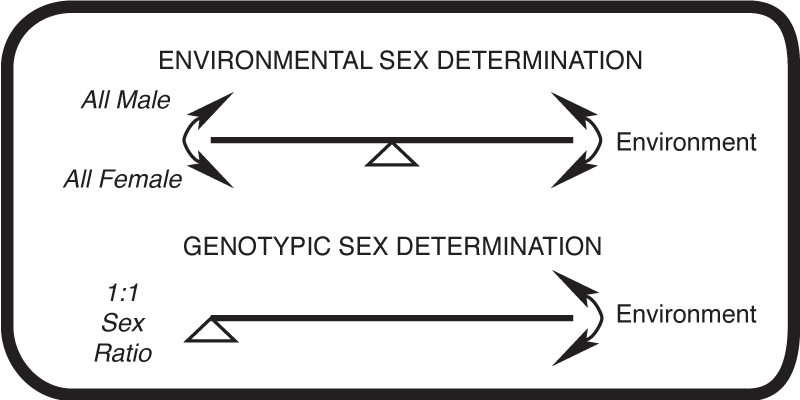First Problem
Many reptile species are threatened with extinction. Most of these species exhibit temperature-dependent sex determination; the temperature of the incubating egg, not heritable sex chromosomes, determines the sex of the offspring. This fact is extremely important for conservation efforts because most common incubation methods have led to the overproduction of male individuals. Thus, a conservation program based on egg collection and incubation could actually hasten the decline of natural populations rather than saving them from extinction!
Second Problem
Any conservation program oriented toward incubation of eggs collected in the wild would require expensive precision temperature-control chambers costing thousands of dollars. These chambers are required initially to determine the temperatures that normally produce each sex. In addition, to assess the temperature-sensitive window as well as individual sex, embryos must be killed and autopsied.
Third Problem
Many endangered reptiles live in remote areas that are difficult to access. The relative expense of providing reliable electricity, particularly in Third World countries, is prohibitive. Even if on-site electrical generators are used, these machines are expensive and require maintenance and fuel. Finally, items such as egg incubators in remote sites must be made secure.
Solution
Implement hormone-spotting method in remote sites. This method guarantees the production of female hatchlings. It is simple, effective, and inexpensive, costing approximately $20 for 250,000 eggs. Natural nests would be excavated, the eggs treated, and the eggs re-buried to incubate. This method has been shown to be effective in both sea turtles (Ridley) and freshwater turtles (Cagle’s map), both of which are threatened.
Synopsis of Research Work by Reptile Conservation International
Until recently it has been assumed that all vertebrates had sex chromosomes and the sex of the offspring fixed at fertilization. With sex chromosomes the sex ratio is 1:1 and apparently immutable. However, many reptiles do not have sex chromosomes; rather, sex is determined during the mid-trimester of development by the temperature at which the egg is incubated. This process is called temperature-dependent sex determination or TSD. In TSD, the effect of incubation temperature is unequivocal. The offspring is either a male or a female; hermaphrodites or intersexes are extremely rare. In addition, research using the red-eared slider as a model system has shown that application of steroid hormones can override the effect of temperature. Thus, both temperature and sex hormones can determine sex in many egg-laying reptiles. The importance of TSD is not of esoteric interest only to herpetologists. TSD represents the primitive sex-determining mechanism that gave rise to systems using sex chromosomes in mammals, including man.
TSD also has ecological significance. The majority of endangered reptiles are TSD species, including sea turtles, Galapagos tortoises, alligators and crocodiles. Perhaps the best-known of these examples is the sea turtle. Because of their economic value, sea turtles have been exploited to the point of extinction in many areas of the world. Many conservation programs worldwide presently collect eggs and incubate them in captivity, usually in Styrofoam buckets, to prevent predation and poaching. These programs are not only logistically difficult but many, ironically, produce a high number of male sea turtles. These practices thus can have a negative effect on conservation of wild populations by skewing the sex ratio toward males.
The discovery that the topical application of estrogen will fully override the masculinizing effects of temperature to produce a female hatchling has immediate practical implications for conservation biology. Research at the University of Texas at Austin by David Crews with leopard geckos indicates that these estrogen-induced individuals grow up to lay eggs as would a normal female. Thus, the estrogen-induced sex determination would not only help rectify past conservation efforts, but quickly lead to the recovery of populations of endangered turtles and crocodilians by skewing the sex ratio towards more breeding females. This method also circumvents the need for transporting costly egg incubators into primitive nesting beach locations. This method is “low-tech, low-cost;” $25 of hormone is sufficient to treat 250,000 eggs!
The impact of the technique can be seen in the following example. Let us assume that 10 breeding females exist and that each female will produce 30 eggs each year. Let us assume also that the young become sexually mature in their third year. Finally, we will assume that a 50:50 sex ratio occurs in unmanipulated animals. In all examples no mortality is considered and each female produced has equal fecundity. [These assumptions clearly are unrealistic, but any decreases in production will be equivalent in the various scenarios.] With the use of hormone-induced sex determination, the number of females will increase exponentially, with 10,200 females being produced over a four-year period compared to 2,700 females produced with no manipulation; at the end of seven years this difference becomes 633,100 versus 56,150!

